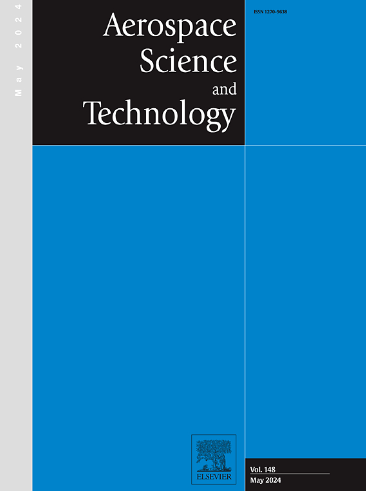小型旋转爆震发动机平均和高频壁面热流特性实验研究
IF 5.8
1区 工程技术
Q1 ENGINEERING, AEROSPACE
引用次数: 0
摘要
本文研究了旋转爆震燃烧室的壁面热流特性,该燃烧室表现出与传统爆燃燃烧室不同的独特热行为。利用甲烷/GOX作为推进剂,设计并实现了紧凑型旋转爆震发动机的一系列试验。通过高频热流密度测量,分析瞬时热流密度分布和平均热流密度分布以及热流密度畸变特征。系统考察了质量流量和等效比对热流密度的影响,并引入了三个无量纲参数来量化热负荷波动。研究结果表明,燃烧室壁面经历了高频周期性热载荷,其频率与旋转爆震波的频率一致。在一定质量流量下,爆轰区平均热流和总热流都随当量比的增加先上升后下降,在1.2 ~ 1.3范围内达到最大值。爆轰区域的热流密度波动强度最大,一般在1.5 ~ 2.5之间。在稳定爆轰模式下,周向畸变强度稳定在4% ~ 6%。当当量比小于1时,轴向畸变强度保持在40%-50%之间,而当当量比大于1时,轴向畸变强度迅速增加,这可能是由于爆轰和爆燃之间的竞争性相互作用。这些结果为rdc的热防护设计提供了重要的见解,并推动了RDEs的工程应用。本文章由计算机程序翻译,如有差异,请以英文原文为准。
Experimental study of average and high-frequency wall heat flux characteristics in a compact rotating detonation engine
This study investigates the wall heat flux characteristics of rotating detonation combustors, which exhibit unique thermal behaviors distinct from traditional deflagration-based combustion chambers. A series of experimental tests on a compact rotating detonation engine were designed and implemented, utilizing methane/GOX as propellants. High-frequency heat flux measurements were conducted to analyze instantaneous and average heat flux distributions, as well as heat flux distortion characteristics. The effects of mass flow rate and equivalence ratio on heat flux were systematically examined, and three dimensionless parameters were introduced to quantify thermal load fluctuations. The key findings show that the combustor walls experience high-frequency periodic thermal loads, with frequencies consistent with those of the rotating detonation waves. At a constant mass flow rate, both the average heat fluxes in the detonation region and the global heat flux initially rise and then decline with increasing equivalence ratios, reaching maximum values within the range of 1.2–1.3. The heat flux fluctuation intensity is highest in the detonation region, typically ranging between 1.5 and 2.5. The circumferential distortion intensity remains stable at 4%–6% under stable detonation modes. The axial distortion intensity remains within 40%–50% for equivalence ratios below 1 but increases rapidly for equivalence ratios above 1, likely due to the competitive interaction between detonation and deflagration. These results provide critical insights for the thermal protection design of RDCs and advance the engineering application of RDEs.
求助全文
通过发布文献求助,成功后即可免费获取论文全文。
去求助
来源期刊

Aerospace Science and Technology
工程技术-工程:宇航
CiteScore
10.30
自引率
28.60%
发文量
654
审稿时长
54 days
期刊介绍:
Aerospace Science and Technology publishes articles of outstanding scientific quality. Each article is reviewed by two referees. The journal welcomes papers from a wide range of countries. This journal publishes original papers, review articles and short communications related to all fields of aerospace research, fundamental and applied, potential applications of which are clearly related to:
• The design and the manufacture of aircraft, helicopters, missiles, launchers and satellites
• The control of their environment
• The study of various systems they are involved in, as supports or as targets.
Authors are invited to submit papers on new advances in the following topics to aerospace applications:
• Fluid dynamics
• Energetics and propulsion
• Materials and structures
• Flight mechanics
• Navigation, guidance and control
• Acoustics
• Optics
• Electromagnetism and radar
• Signal and image processing
• Information processing
• Data fusion
• Decision aid
• Human behaviour
• Robotics and intelligent systems
• Complex system engineering.
Etc.
 求助内容:
求助内容: 应助结果提醒方式:
应助结果提醒方式:


